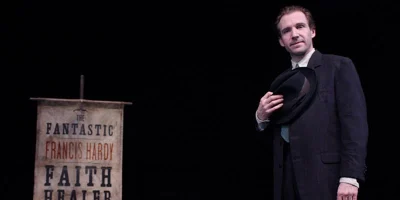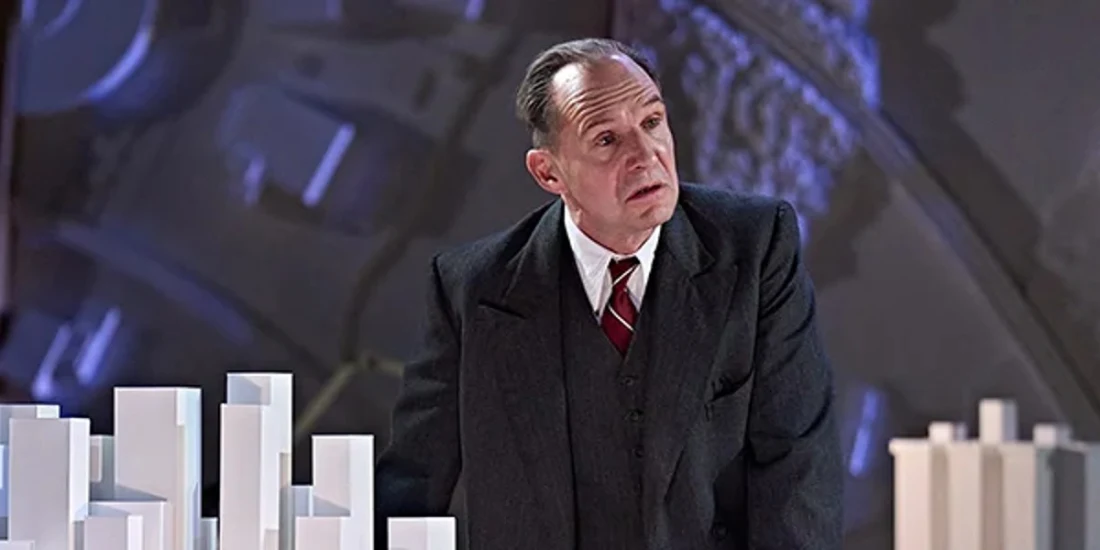
The real NYC history that inspired 'Straight Line Crazy'
Ralph Fiennes stars as Robert Moses in David Hare's Off-Broadway play.
Even if you don't know Robert Moses's name, you probably know his work. Any New Yorker or visitor who has ever driven on an interborough bridge, played in a city playground or pool, or caught a show at Lincoln Center has Moses to thank. Between the 1920s and 1960s, Moses, a city planner, oversaw the creation of New York City as we know it today. His rise to power, the negative effects of that power, and his most infamous projects — successful and failed — are the subject of a new play by David Hare, Straight Line Crazy.
Academy Award nominee Ralph Fiennes makes his Off-Broadway debut as Moses, reprising his acclaimed performance from the play's world premiere in London earlier this year. In New York, the play is going up at The Shed, where the very infrastructure the play deals with is mere blocks away. Moses's legacy is baked into the fabric of the city, but not even all New York residents know the history behind his most famous projects. Learn more about Moses and how his work inspired Straight Line Crazy, then make a beeline to Hudson Yards to see the play for yourself through December 18.
Get Straight Line Crazy tickets now.
Who was Robert Moses?
Robert Moses was one of the most influential public officials in New York City history — and yet he never even got elected to public office. He did hold multiple appointed titles, though, heading up various planning committees — sometimes up to 12 at once. He headed up the New York State Council of Parks, New York City Department of Parks, Triborough Bridge and Tunnel Authority, New York City Planning Commission, and Jones Beach Parkway Authority, all for 25 years or more, and sat on multiple other committees for shorter terms. Moses was even the New York Secretary of State for two years.
Together, these various titles gave Moses outsized power to shape how New York City was built. He oversaw the renovation and ground-up creation of highways, bridges, parks, pools, playgrounds, beaches, and more in the five boroughs and Long Island. He's now remembered for destroying lots of infrastructure to push his projects through, too, but regardless, his influence is undeniable. Lots of the infrastructure he built is still in place, and he shaped not only how New York City developed, but how lots of other U.S. cities developed, mimicking Moses's work.
"Straight line crazy"
Where did Hare's play get its name? The title is part of a quote from Iphigene Ochs Sulzberger, who was president of NYC's Parks Commission from 1936 to 1963. Moses served as commissioner of the Parks Department from 1934 to 1960, so they worked closely together. In fact, she was an outspoken supporter of his, as she appreciated their shared interest in revitalizing the NYC parks system.
But that doesn't mean they always agreed on how to go about it. Her ideal park had plenty of nature, whereas Moses's plans involved paving over green space to build playgrounds, basketball courts, and parking lots. In a famous biography of Moses, The Power Broker, Robert Caro quotes Sulzberger as saying, "Engineers are straight-line crazy."
This quote is, of course, part of the show it's named for, but Sulzberger isn't a character in Straight Line Crazy. Activist Jane Jacobs says the line instead, while arguing against Moses's plan to build a road through Washington Square Park. The quote itself refers to Moses's obsession with doing everything for the sake of efficiency — like building straight roads through parks — rather than leaving some things alone for human enjoyment.
No way but the highway
To Moses, a car-forward city was the best type of city. He favored cars over public transportation, so he put his resources toward building highways and bridges. As chairman of the Triborough Bridge Authority for 34 years, he got multiple bridges built for car travel. The Robert F. Kennedy Bridge (then the Triborough Bridge), which connects Manhattan, Queens, and the Bronx; the Brooklyn-Battery Tunnel between Brooklyn and Lower Manhattan; the Throgs Neck Bridge between the Bronx and Queens, and many more were constructed under Moses's oversight.
He also helped build, among multiple other Long Island parkways, the Meadowbrook State Parkway to Long Island, which was the first fully divided, limited-access highway in the world. Plus, Moses is responsible for creating Jones Beach State Park — the country's most frequented public beach — and the highway system that connects it to NYC.
Moses saw these projects as a benefit to working-class people. Highways, he believed, provided a convenient, direct way for people to escape to the beach from their tenements on weekends. This is what Straight Line Crazy's first half is all about: Moses uses this exact reasoning to convince Governor Al Smith to approve the highways. In Hare's framing, this optimistic vision showed its dark flip side later in Moses's career: His negative view of tenements led him to demolish low-income neighborhoods, displacing many people who couldn't afford to move into renovated developments.
Washington Square Park
Moses successfully built lots of highways, bridges, playgrounds, and cultural centers, but not all his projects succeeded. Moses's most infamous failure was his plan to build a road directly through the middle of Washington Square Park in the 1950s. Not just any road — a four-lane, two-way extension of Fifth Avenue that would feed into a Lower Manhattan Expressway, with an overpass to allow pedestrians to cross between the two sides of the park.
His proposal received immediate backlash, namely from Jacobs, a neighborhood resident. She organized a grassroots movement against the road, which attracted everyone from ordinary citizens to prominent figures like Eleanor Roosevelt. Due to her efforts, the road and the entire Lower Manhattan Expressway were canceled. A few years later, when associates of Moses's tried to designate a section of Greenwich Village a slum in order to raze and redevelop it, Jacobs fought against that, too.
The second half of Straight Line Crazy focuses on Moses's failed alterations to the park and Greenwich Village, and Jacobs is a key character in this part of the play. She acts as a foil to him: He refuses to change his decades-old views that highways will solve all the city's problems. Jacobs, in contrast, adapts to the times and is more in tune with what the neighborhood residents actually want.
Lincoln Center
Though he clashed with some organizers like Jacobs, Moses had plenty of public support when he was actively working for the city, especially in the first half of the 20th century. Lots of New York residents did like his efficiency — unlike the government at the time, he actually put plans in motion and got things built. In the later years of his career and since his death, however, Moses's legacy has become more contentious. He got infrastructure built, yes, but he was obsessed with "slum clearance," and he razed multiple low-income, minority neighborhoods to make way for upscale buildings.
One of the most well-known examples is Lincoln Center for the Performing Arts. Now a tourist attraction and a hub for opera, ballet, theatre, and symphonies, the area used to be a neighborhood called San Juan Hill. The majority-Black and Latino residents of that neighborhood were displaced in the 1950s and 60s when their tenements were destroyed and Lincoln Center was built, under Moses's purview.
Lincoln Center's construction isn't a main focus of Straight Line Crazy, but the play's second half is about Moses's fall from grace and his inability to accept that his "perfect" city had negative side effects on thousands of New York residents, which Lincoln Center exemplified.
Straight Line Crazy isn't the only show to reference this project. The opening shot of Steven Spielberg's 2021 West Side Story film remake shows a blueprint for Lincoln Center, with a wrecking ball and rubble in the background. Another scene shows anti-demolition protestors, one of whom holds a sign calling Moses out by name.
Moses's legacy
A major reason many don't remember Moses fondly today is because of The Power Broker. Robert Caro's 1974 biography hails Moses for his early achievements, like the building of Jones Beach and refurbishing of NYC's parks, and notes that his work prompted lots of cities to create highways and new housing developments of their own. But Caro also paints him as a morally questionable man, personally and professionally. He argues that Moses was racist and careless in his methods, and was more concerned with power than residents' best interests. For example, he noted that Moses's limited-access highways only allowed cars, shutting out minority and lower-income people who could only afford bus travel.
The Power Broker did not win Moses's approval (he issued a 23-page criticism of the book), but it did win the Pulitzer Prize and a lasting place in New York history, single-handedly changing Moses's legacy. But whether you've read the book or just know of it, and Moses, through word-of-mouth, you'll see a fresh perspective on the man in Straight Line Crazy.
Hare was inspired by The Power Broker when writing about Moses, but this isn't a stage adaptation of that book. He takes a different angle than Caro: As Hare said to the New Yorker, his Moses is not ruthlessly power-hungry, but "a man trapped in a dream," struggling to accept that his idealized plans aren't ideal in practice and not opening himself to change. Straight Line Crazy takes a more neutral approach to Moses's character than The Power Broker, letting audiences decide for themselves how to remember the man and his city.
Originally published on
